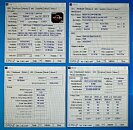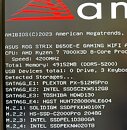T0@st
News Editor
- Joined
- Mar 7, 2023
- Messages
- 3,085 (3.90/day)
- Location
- South East, UK
| System Name | The TPU Typewriter |
|---|---|
| Processor | AMD Ryzen 5 5600 (non-X) |
| Motherboard | GIGABYTE B550M DS3H Micro ATX |
| Cooling | DeepCool AS500 |
| Memory | Kingston Fury Renegade RGB 32 GB (2 x 16 GB) DDR4-3600 CL16 |
| Video Card(s) | PowerColor Radeon RX 7800 XT 16 GB Hellhound OC |
| Storage | Samsung 980 Pro 1 TB M.2-2280 PCIe 4.0 X4 NVME SSD |
| Display(s) | Lenovo Legion Y27q-20 27" QHD IPS monitor |
| Case | GameMax Spark M-ATX (re-badged Jonsbo D30) |
| Audio Device(s) | FiiO K7 Desktop DAC/Amp + Philips Fidelio X3 headphones, or ARTTI T10 Planar IEMs |
| Power Supply | ADATA XPG CORE Reactor 650 W 80+ Gold ATX |
| Mouse | Roccat Kone Pro Air |
| Keyboard | Cooler Master MasterKeys Pro L |
| Software | Windows 10 64-bit Home Edition |
Hardware leaker MEGAsizeGPU has uploaded photos of unreleased G.Skill DIMMs—they claim that the leaked hardware "is the world's first 24G*2 DDR5 expo module: F5-6000J4048F24GX2-TZ5NR." The next-gen Trident Z5 memory is said to be rated for a 6000 MT/s data transfer rate, and close-up shots of labels on heatsinks point to the sample units being non-binary 24 GB DDR5 memory modules that can support EXPO profiles for AMD's Ryzen 7000-series CPUs. MEGAsizeGPU claims that "6000 MHz is the sweetspot for Ryzen" (AM5).
Off-screen captures show a PC system booting up in DDR5-6000 mode—within a Windows OS environment, CPU-Z demonstrates that these new Trident Z5 modules are based on SpecTek-made 24Gb DRAM ICs (instead of binary 16Gb)—SpecTek is a division working under Micron Technology. G.SKILL will likely be selling non-binary Z5 memory in pairs, so we expect to see matched 48 GB dual-channel kits popping up on the market soon. MEGAsizeGPU did not mention anything about pricing or availability. Kingston debuted its own non-binary memory offerings at Computex 2023, but presentation material on hand did not mention whether their new models support AMD's Extended Profiles for Overclocking (EXPO).




View at TechPowerUp Main Site | Source
Off-screen captures show a PC system booting up in DDR5-6000 mode—within a Windows OS environment, CPU-Z demonstrates that these new Trident Z5 modules are based on SpecTek-made 24Gb DRAM ICs (instead of binary 16Gb)—SpecTek is a division working under Micron Technology. G.SKILL will likely be selling non-binary Z5 memory in pairs, so we expect to see matched 48 GB dual-channel kits popping up on the market soon. MEGAsizeGPU did not mention anything about pricing or availability. Kingston debuted its own non-binary memory offerings at Computex 2023, but presentation material on hand did not mention whether their new models support AMD's Extended Profiles for Overclocking (EXPO).




View at TechPowerUp Main Site | Source



 both have the same primary timings. Also I realized I wrote 5200 and not 5600. Oops! Time to fix that.
both have the same primary timings. Also I realized I wrote 5200 and not 5600. Oops! Time to fix that.
